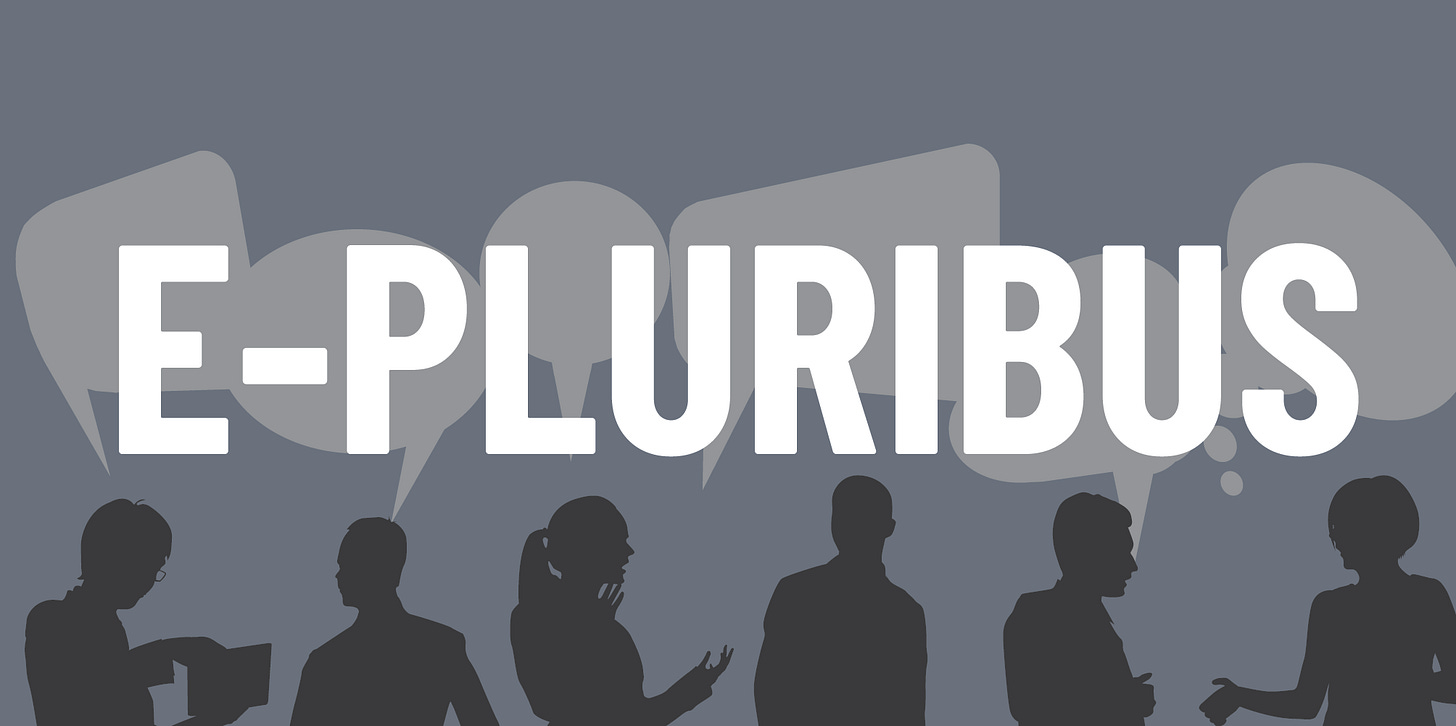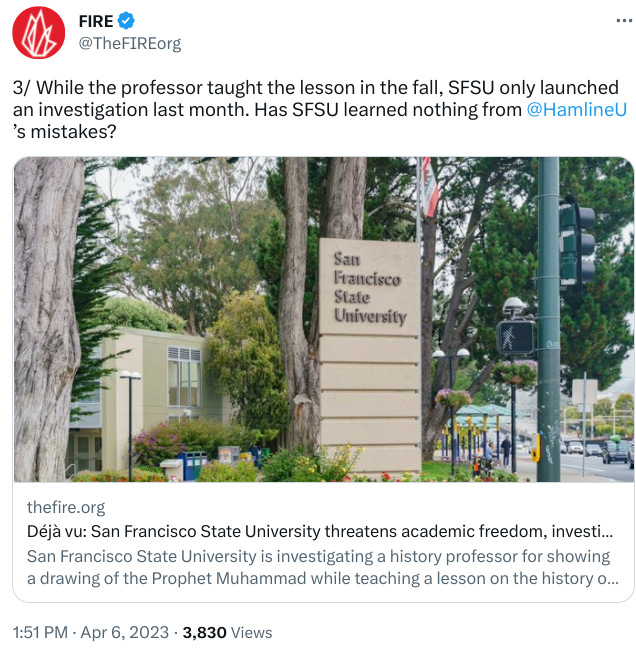E-Pluribus | April 7, 2023
When "censorship" isn't censorship, and a "ban" is not a ban; Madisonian pluralism; and can DEI statements be redeemed?
A round-up of the latest and best writing and musings on the rise of illiberalism in the public discourse:
Daniel Buck: Book Curation Is Not Censorship
Daniel Buck at National Review writes that many of the claims of censorship involving libraries these days amount to The Boy Who Cried Book Banning. Buck writes that determining age-appropriate access to books is not an exact science and there’s room for disagreement and debate, but in no way does it always amount to a “ban.”
Of course, lurking behind all of this hyperventilation over supposed book banning, there’s a simple truth that needs to be said: None of these books have been banned, none of them have been censored. . .
In reality, there’s a drastic difference between government censors black-bagging dissidents for distributing samizdat materials, large corporations like Amazon or Target deplatforming a book, school libraries taking a text off their shelves, and a school replacing one book on their curriculum with another. Lumping all of these together under the term “censorship” — or, at the most panicked, associating them with Nazi book burnings — inhibits our ability to discuss the real, consequential, and ancient debate in question here: What should our kids read?
[ . . . ]
There are countless reasons to choose one or another book for instruction: aesthetic value, difficulty, breadth of topics, genre variety, age-appropriateness, and historical significance. Even in the case of Maus, it would be entirely reasonable for a school to remove it from a reading list if students had already read another Holocaust book in a prior grade but hadn’t yet read a slave narrative.
In my own teaching, I have to make curricular decisions all the time. The inclusion of one book necessitates the exclusion of another. I’ve taught every grade from fifth through twelfth. I never taught Romeo and Juliet to fifth-graders because of its difficulty, violence, and sexual themes, but I taught it in high school. There’s a near-infinite number of books that I never taught, but at no point does this mean I banned any of them.
Read it all here.
David French: ‘James Madison’s Vision of Pluralism’
The Founders’ ideals clearly ran ahead of their personal actions, and James Madison was no different. In an interview with The Bulwark, David French lays out Madison’s view of pluralism.
David French: So James Madison wrote Federalist No. 10, which is the best Federalist paper—the best Federalist paper. In Federalist 10, what James Madison does is he talks about expanding the sphere of the American republic. In other words, the way that you deal with the dissent and debate and profound disagreements in what he calls the “danger” or the “violence” of faction is not by trying to suppress factions, because then you’re aiming straight at liberty, you’re gunning straight for liberty, which undermines the American republic, the American experiment. So Madison says, you can’t do that.
(Here’s the caveat: This is a guy who was a slave owner, so was he living up to his ideals? No. Are the ideals as described in Federalist 10 good? Yes.)
So what does he say in Federalist 10? He says, what you essentially need to do is to dilute the disruptive power of faction by allowing factions to bloom. In other words, you don’t have to defeat or suppress another person to live according to your core values. The sphere of liberty in the U.S. is broad enough to where a variety of communities can live side by side with each other, people who have dramatically different points of view can live side by side with each other, possess the same amount of liberty, possess the same rights of free association and all of the things that we possess to allow us to create thriving communities. And we expand the sphere, we make the sphere of liberty bigger.
We make the sphere of faction bigger so that we don’t have that zero-sum game where if Democrats win, then somehow my ability to live according to my core values diminishes; or if Republicans win, the Democrats’ ability to live according to their core values diminishes. And so that’s sort of this core vision of pluralism.
Read the whole thing.
Justin P. McBrayer and Sarah Roberts-Cady: Centering Students in the Diversity Statement Debate
Is it possible to improve and save the much-maligned “diversity statements” that many universities require from incoming hires? At Inside Higher Education, two Fort Lewis College professors detail their vision of how such statements can still serve a purpose in determining who can best help institutions achieve their educational goals.
This breadth of student diversity means that we need to hire faculty and staff who know that a one-size-fits-all approach is unlikely to serve our most vulnerable students. Instead, we want professors who will meet our students where they are. We want employees who are aware of the barriers our students face and have an empirically grounded set of strategies for reducing those barriers and meeting their needs. In short, we want faculty and staff who are equipped to support a demographically, neurologically and culturally diverse student body.
Given that need, what should we ask job candidates applying for academic positions? Whether hiring committees are requesting a diversity statement or not, it is important that these committees ask for and evaluate relevant information. Job candidates already submit cover letters for jobs, and they can use those letters to explain how they are qualified to serve students well. That’s what our institution, Fort Lewis College, does, and it’s been a great way to find faculty who are well prepared to serve our unique student body.
At least in the context of academic positions, a good application or diversity statement will (a) demonstrate awareness of the problems/challenges students face, (b) demonstrate knowledge of the empirical research for effective solutions to those problems and (c) provide examples of the applicant’s experience or willingness to implement that knowledge.
[W]e want employees who have a clear grasp on the various barriers to success that today’s students face. While it’s obviously too much to expect applicants to know about all possible hurdles to student success, they should have a pretty good sense of specific challenges students face in their own discipline (e.g., women in engineering) or challenges faced by specific populations served at the institution to which they are applying (e.g., an historically Black college). And while understanding of general trends and specific challenges in an institution are important, there should also be a recognition of the ways race, gender and other factors interact, creating different challenges for different students.
Read it all.
Around Twitter
Note, via Substack: “Twitter has unexpectedly restricted access to embedding tweets in Substack posts. Our team is working to resolve this issue as soon as possible.” This issue has required screenshots of tweets in today’s round-up and an abbreviated Around Twitter today.
Via the Foundation for Individual Rights & Expression, lightning strikes twice:
Conor Friedersdorf has been doggedly trying to get advocates of DEI (diversity, equity and inclusion) to provides examples of a DEI bureaucracy that has produced positive results, and his latest attempt has again come up short with respondents more inclined to question his motives instead:
And finally, self-referential, but important nonetheless:











